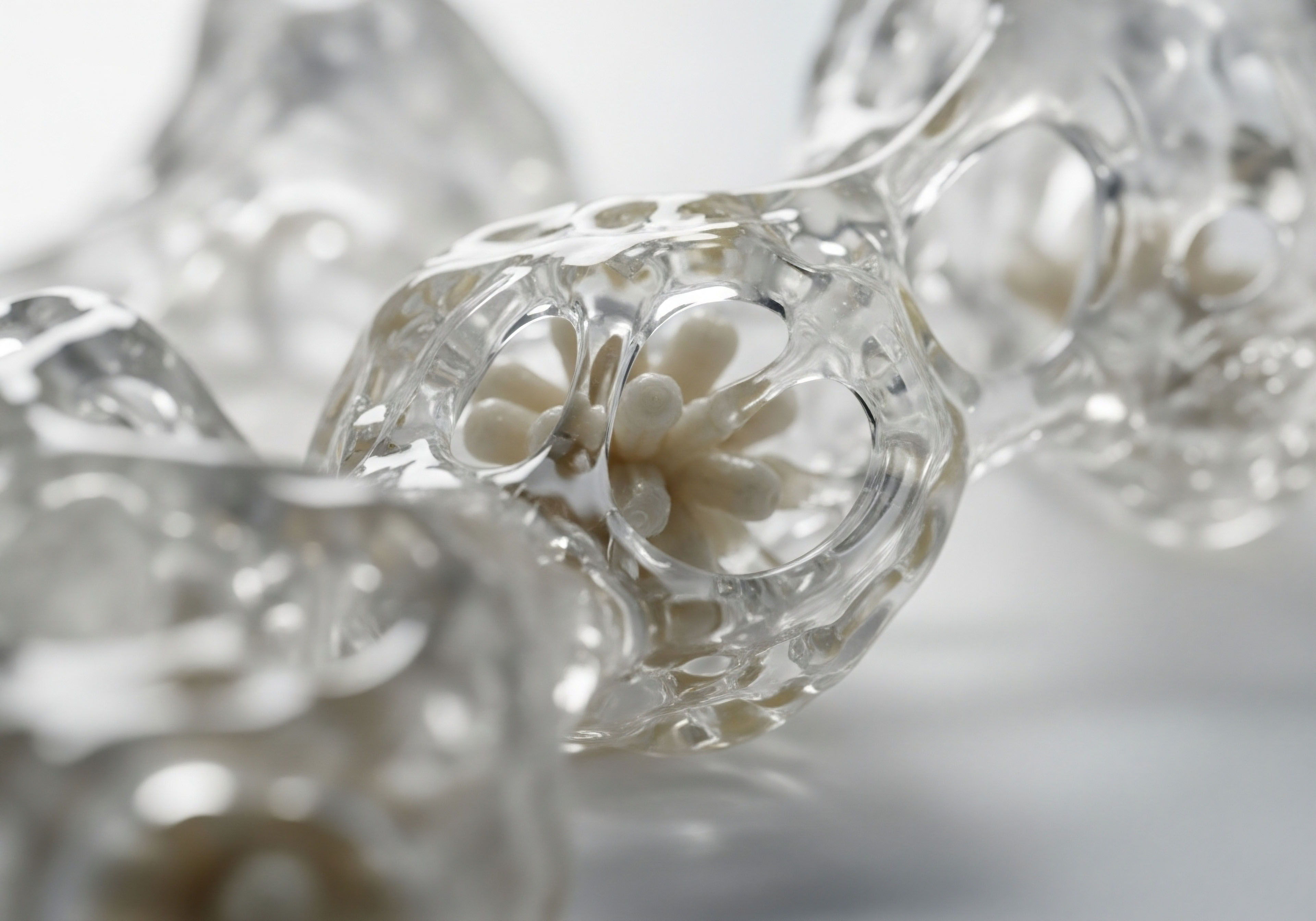

Fundamentals
You may be holding this information because of a feeling, a subtle or significant shift within your body that you are trying to understand. It could be a change in your energy, your sleep, your emotional state, or a sense that your own biology is operating with a new set of rules.
These experiences are valid data points. They are your body’s method of communicating a profound change in its internal environment. The conversation around hormonal health, particularly for women, has often been clouded by confusion and fear, leaving many to navigate this personal evolution without a clear map. My purpose here is to provide that map, translating the complex language of your endocrine system into clear, actionable knowledge. We begin by addressing a central molecule in this story ∞ progesterone.

Understanding Progesterone’s Identity
Progesterone is a C-21 steroid hormone, meaning it is derived from cholesterol, the same parent molecule for all your other sex and stress hormones. Its production primarily occurs in the ovaries’ corpus luteum after ovulation, with smaller amounts synthesized by the adrenal glands and, during pregnancy, by the placenta.
This molecule is a fundamental biological messenger with a primary, well-understood role in regulating the menstrual cycle and sustaining a healthy pregnancy. Its actions prepare the uterine lining, or endometrium, for potential implantation and help maintain the uterine environment throughout gestation.
These reproductive functions are where the conventional definition of progesterone often ends. This limited view fails to capture its systemic influence. Progesterone receptors are not confined to the uterus; they are found throughout the body, including in the brain, the bones, and critically, within the entire cardiovascular system.
The presence of these receptors in your blood vessels and heart tissue is a definitive statement from your own biology ∞ progesterone’s work extends far beyond reproduction. It is an integral part of maintaining your overall physiological equilibrium.
The distinction between bioidentical progesterone and synthetic progestins is the single most important concept in understanding its cardiovascular effects.

A Critical Distinction Progesterone versus Progestins
The conversation about progesterone is immediately complicated by a case of mistaken identity that has had far-reaching consequences. The term “progesterone” is frequently used interchangeably with “progestin,” yet these molecules are structurally and functionally distinct. This is the source of much of the historical apprehension surrounding hormone therapy.
- Bioidentical Progesterone ∞ This molecule is structurally identical to the one your body produces. Micronized progesterone, a common form used in clinical protocols, is simply progesterone processed into very small particles to enhance its absorption when taken orally. Its molecular shape allows it to fit perfectly into the body’s progesterone receptors, initiating the same cascade of downstream biological effects that your endogenous hormone would.
- Synthetic Progestins ∞ These are laboratory-created molecules designed to mimic some of the effects of progesterone. Medroxyprogesterone acetate (MPA) is perhaps the most well-known example, widely used in past hormonal therapies and the subject of much controversy. While progestins can bind to progesterone receptors, their different molecular structure means they can also interact with other steroid hormone receptors (like androgen or glucocorticoid receptors) and their effect on the progesterone receptor itself can be different. These off-target interactions and altered primary effects are responsible for a significantly different side-effect profile, particularly concerning cardiovascular health.
Large-scale clinical trials in the past, which reported increased cardiovascular risks with combined hormone therapy, predominantly used synthetic progestins like MPA. The conclusions from that research were unfortunately generalized to all progestogenic hormones, creating a persistent fear around progesterone itself. Current clinical science, however, draws a bright line between the two, with a growing body of evidence indicating that bioidentical progesterone has a neutral or even beneficial cardiovascular profile.

How Does Progesterone Communicate with the Cardiovascular System?
Imagine your cardiovascular system as a vast network of dynamic, responsive roadways. The flexibility and openness of these roads, your blood vessels, are essential for healthy blood flow and stable blood pressure. Progesterone acts as a key traffic controller in this system.
One of its primary mechanisms is through influencing vasodilation, the relaxation or widening of blood vessels. It achieves this by stimulating the production of nitric oxide, a potent signaling molecule in the lining of the blood vessels, known as the endothelium. Increased nitric oxide signals the smooth muscles in the vessel walls to relax, which lowers blood pressure and improves circulation. This action is a foundational element of its protective cardiovascular role.
Furthermore, progesterone has a mild diuretic effect because it competes with the hormone aldosterone, which instructs the kidneys to retain salt and water. By gently opposing aldosterone, progesterone can help the body excrete excess fluid, another mechanism that contributes to healthy blood pressure regulation. These actions are intrinsic to the progesterone molecule your body makes.
They represent a part of the biological wisdom that maintains systemic balance, a balance that can be supported and restored through clinically appropriate, personalized hormonal protocols.


Intermediate
Advancing our understanding requires moving from progesterone’s identity to its specific actions within the cardiovascular theater. The implications of long-term progesterone use are written in the language of lipid profiles, blood pressure readings, and inflammatory markers.
A nuanced examination reveals that bioidentical progesterone behaves as a team player within the endocrine system, often working to support vascular health and counteract some of the less desirable effects of other metabolic processes. This contrasts sharply with the disruptive influence observed with certain synthetic progestins.

Progesterone’s Direct Influence on Vascular Tone and Blood Flow
The health of the endothelium, the single-cell-thick lining of all blood vessels, is paramount to cardiovascular wellness. This delicate layer is a highly active metabolic and endocrine organ. One of its most vital functions is the production of nitric oxide (NO), the body’s primary vasodilator. The synthesis of NO is carried out by an enzyme called endothelial nitric oxide synthase (eNOS).
Bioidentical progesterone has been shown to directly interact with endothelial cells to promote the activity of eNOS. This interaction happens through both rapid, non-genomic pathways involving membrane-bound progesterone receptors and slower, genomic pathways that influence gene expression. The result is an increase in NO production.
An increase in NO leads to the relaxation of vascular smooth muscle, which translates to wider, more pliable arteries. This process improves blood flow, reduces resistance against which the heart has to pump, and contributes to the maintenance of healthy blood pressure. Some studies suggest this vasorelaxant effect is a key contributor to progesterone’s cardioprotective potential.
Progesterone’s ability to promote nitric oxide synthesis is a direct mechanism through which it supports vascular flexibility and healthy blood pressure.

How Do Different Progestogens Affect Lipid Metabolism?
Your lipid panel, which measures cholesterol and triglycerides, is a critical dataset for assessing cardiovascular risk. Estrogen therapy is known to have beneficial effects on lipids, primarily by increasing high-density lipoprotein (HDL), the “good” cholesterol, and decreasing low-density lipoprotein (LDL), the “bad” cholesterol. A central question in combined hormone therapy is how the addition of a progestogen modifies these effects. Here, the distinction between progesterone and progestins becomes starkly clear.
The Postmenopausal Estrogen/Progestin Interventions (PEPI) trial was a landmark study that provided valuable data on this topic. It found that oral micronized progesterone, when added to estrogen, largely preserved the beneficial HDL-raising effects of estrogen. In contrast, synthetic progestins, particularly those with more androgenic properties, were shown to attenuate or negate this positive effect on HDL. This demonstrates that the choice of progestogen is a determining factor in the overall cardiovascular impact of a hormonal optimization protocol.
| Marker | Bioidentical Progesterone (Micronized) | Synthetic Progestin (e.g. Medroxyprogesterone Acetate – MPA) |
|---|---|---|
| HDL Cholesterol | Largely neutral effect; preserves the HDL-increasing benefit of estrogen. | Tends to lower or blunt the rise in HDL caused by estrogen. |
| Blood Pressure | Neutral or may cause a slight decrease due to vasodilation and mild diuretic effects. | Variable effects; some progestins may increase blood pressure. |
| Vascular Reactivity | Promotes vasodilation via nitric oxide production. | May induce vasoconstriction, opposing estrogen’s beneficial effects. |
| Inflammation | Exhibits anti-inflammatory properties in certain contexts. | May have pro-inflammatory effects, which can contribute to vascular risk. |

Clinical Protocols and Cardiovascular Considerations
In a therapeutic setting, such as for a peri- or post-menopausal woman, progesterone is most often prescribed alongside estrogen. Its primary role in this context is to protect the endometrium from the proliferative effects of unopposed estrogen, thereby reducing the risk of endometrial cancer. The cardiovascular implications are a secondary, yet equally important, consideration in designing the protocol.
A standard protocol for a woman with an intact uterus involves continuous estrogen and cyclical or continuous progesterone. For example, a woman might use a transdermal estrogen patch or gel daily, supplemented with oral micronized progesterone (e.g. 100-200mg) taken at night for 12-14 days a month (cyclical) or every day (continuous).
The choice of oral micronized progesterone is deliberate. Its favorable profile regarding lipids and blood pressure makes it the preferred partner to estrogen for long-term cardiovascular safety. This careful selection is a hallmark of modern, evidence-based hormonal optimization, aiming to achieve symptomatic relief while actively supporting systemic health.


Academic
A sophisticated analysis of progesterone’s long-term cardiovascular role requires an inquiry into its molecular mechanisms of action, specifically the differential signaling pathways activated by its various receptor isoforms. The net effect of progesterone on vascular tissue is a composite of genomic and non-genomic signals that are cell-type specific and modulated by the local hormonal milieu. The academic perspective moves beyond observing effects on lipids and blood pressure to understanding the intricate cellular choreography that produces these outcomes.

What Are the Roles of Progesterone Receptor Isoforms in Vascular Biology?
The biological effects of progesterone are mediated primarily by two classical nuclear receptor isoforms, Progesterone Receptor-A (PR-A) and Progesterone Receptor-B (PR-B), which are transcribed from the same gene but initiated at different start sites.
These receptors function as ligand-activated transcription factors, meaning they bind to progesterone, translocate to the cell nucleus, and regulate the expression of target genes. Both PR-A and PR-B are expressed in vascular smooth muscle cells and endothelial cells, but their relative ratio can dictate the cellular response.
PR-B is generally considered the more potent activator of gene transcription. In contrast, PR-A can sometimes act as a repressor of PR-B activity and the activity of other steroid receptors. This differential activity suggests that the PR-A to PR-B ratio within a specific vascular cell is a critical determinant of how that cell will respond to circulating progesterone.
For example, a higher PR-A ratio might temper proliferative signals, contributing to vascular stability. Human aorta vascular smooth muscle cells express more PR-A in women than in men, hinting at a sexually dimorphic regulation of vascular tone by progesterone.
Adding another layer of complexity are the non-classical, membrane-bound progesterone receptors (mPRs), such as mPRα, and the more recently characterized mitochondrial progesterone receptor (PR-M). These receptors mediate progesterone’s rapid, non-genomic effects. The stimulation of nitric oxide production in endothelial cells within minutes of progesterone exposure is a classic example of mPR-mediated signaling.
This action occurs far too quickly to be the result of gene transcription and instead involves the rapid activation of intracellular signaling cascades like the PI3K/Akt and MAP kinase pathways, which in turn phosphorylate and activate the eNOS enzyme.
| Receptor Isoform | Location | Primary Mechanism of Action | Key Cardiovascular Effect |
|---|---|---|---|
| PR-B (Nuclear) | Nucleus | Ligand-activated transcription factor (Genomic) | Regulates expression of genes involved in vascular cell growth and function. |
| PR-A (Nuclear) | Nucleus | Ligand-activated transcription factor; can inhibit PR-B (Genomic) | Modulates PR-B activity; may inhibit vascular smooth muscle cell proliferation. |
| mPRα (Membrane) | Cell Membrane | Rapid signal transduction via kinase pathways (Non-Genomic) | Rapidly increases eNOS activation and nitric oxide synthesis. |
| PR-M (Mitochondrial) | Mitochondrial Outer Membrane | Increases cellular respiration and energy production. | Enhances cardiac beta-oxidation and cellular energy to meet physiological demands. |

Why Does Molecular Structure Determine Cardiovascular Outcome?
The divergent cardiovascular effects of bioidentical progesterone versus synthetic progestins can be traced back to their molecular structure and resulting receptor interactions. Bioidentical progesterone’s structure allows it to bind with high fidelity to its intended receptors (PR-A, PR-B, mPRs), initiating a balanced portfolio of genomic and non-genomic effects that tend toward vascular protection.
Synthetic progestins, however, are different. Medroxyprogesterone acetate (MPA), for example, has a structure that, while allowing it to bind to the progesterone receptor, also gives it affinity for the glucocorticoid and androgen receptors. Its action at these other receptors can introduce unintended consequences.
For instance, androgenic activity can counteract the beneficial lipid effects of estrogen, and glucocorticoid activity can negatively influence glucose metabolism and vascular inflammation. Furthermore, MPA does not appear to effectively stimulate the rapid, mPR-mediated nitric oxide release in the same way that natural progesterone does.
This results in a molecule that fails to deliver the key vasodilatory benefits while potentially introducing other adverse metabolic signals. The long-term cardiovascular implications of a hormone are therefore a direct extension of its molecular shape and the specific receptor-binding profile that shape dictates.

How Does Progesterone Interact with Broader Physiological Systems?
Progesterone’s influence extends to systemic regulatory networks like the Renin-Angiotensin-Aldosterone System (RAAS), a critical pathway for managing blood pressure and fluid balance. As mentioned, progesterone acts as a competitive antagonist at the mineralocorticoid receptor, the target for aldosterone. Aldosterone’s primary function is to promote sodium and water retention in the kidneys.
By blocking this action, progesterone induces a mild natriuresis, or excretion of sodium, which is followed by water. This contributes to a reduction in blood volume and can have a favorable impact on blood pressure. This antimineralocorticoid activity is unique to natural progesterone and is not shared by many synthetic progestins, including MPA. This is another clear example of how the specific molecular properties of bioidentical progesterone confer a more favorable cardiovascular profile for long-term use.
The totality of evidence suggests that long-term therapy with bioidentical progesterone, when used appropriately within a personalized clinical protocol, is associated with a neutral to beneficial cardiovascular risk profile. Its mechanisms of action, from promoting vasodilation via nitric oxide to its favorable effects on lipid metabolism and fluid balance, stand in contrast to the potentially detrimental effects of certain synthetic progestins. This understanding is foundational to modern endocrinology and the practice of safe and effective hormonal optimization.

References
- Pang, Y. et al. “Progesterone increases nitric oxide synthesis in human vascular endothelial cells through activation of membrane progesterone receptor-α.” American Journal of Physiology-Endocrinology and Metabolism, vol. 308, no. 9, 2015, pp. E899-E911.
- Price, Thomas M. et al. “A Mitochondrial Progesterone Receptor Increases Cardiac Beta-Oxidation and Remodeling.” Journal of the Endocrine Society, vol. 4, no. 9, 2020, bvaa094.
- Hermenegildo, C. et al. “Cardiovascular effects of medroxyprogesterone acetate and progesterone ∞ a case of mistaken identity?” Nature Clinical Practice Cardiovascular Medicine, vol. 5, no. 1, 2008, pp. 114-6.
- The Writing Group for the PEPI Trial. “Effects of estrogen or estrogen/progestin regimens on heart disease risk factors in postmenopausal women.” JAMA, vol. 273, no. 3, 1995, pp. 199-208.
- Li, X. et al. “Progesterone promotes endothelial nitric oxide synthase expression through enhancing nuclear progesterone receptor-SP-1 formation.” Journal of Cellular Physiology, vol. 235, no. 12, 2020, pp. 9889-9900.
- Prior, Jerilynn C. and Thomas G. Vigna. “Progesterone Therapy, Endothelial Function and Cardiovascular Risk Factors ∞ A 3-Month Randomized, Placebo-Controlled Trial in Healthy Early Postmenopausal Women.” PLoS ONE, vol. 9, no. 1, 2014, e84698.
- Rosano, G. M. and C. Fini. “Comparative cardiovascular effects of different progestins in menopause.” International Journal of Fertility and Women’s Medicine, vol. 47, no. 1, 2002, pp. 18-22.
- Wet-suwan, W. et al. “New insights into the functions of progesterone receptor (PR) isoforms and progesterone signaling.” Biomolecules, vol. 12, no. 10, 2022, p. 1459.

Reflection
The information presented here is a detailed map of a specific biological territory. It provides coordinates, landmarks, and an understanding of the terrain. This knowledge is designed to be a tool, transforming uncertainty into clarity and empowering you with the language to engage in a different kind of conversation about your health.
Your personal health narrative is unique, written by the interplay of your genetics, your history, and your environment. Understanding the science of a molecule like progesterone is the first step. The next is to place that science into the context of your own story.
Consider how these biological mechanisms might relate to your own lived experience. This process of connecting objective science to your subjective reality is where true agency in your health journey begins. The goal is a partnership with your own physiology, guided by data and informed by a deep respect for your body’s intricate systems.



